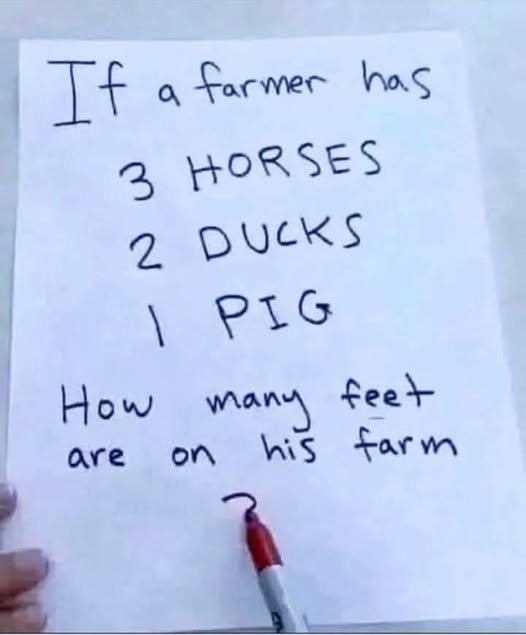Riddles have a funny way of challenging our thinking, often making us question what seems obvious. One such brain teaser goes like this: “If a farmer has 3 horses, 2 ducks, and 1 pig, how many feet are on his farm?” At first glance, most people instinctively jump into calculating how many legs all the animals have. They’ll take the three horses and multiply by four legs each, giving them twelve.

Then they’ll take the two ducks, each with two legs, adding four more. Lastly, the pig has four legs, bringing the total to twenty legs. But the riddle doesn’t ask about legs—it specifically asks about “feet.” And that’s where the trick lies. The word “feet” might seem interchangeable with “legs” at first, but there’s a crucial difference. In English, “feet” refers to a particular kind of limb—typically the flat structures used for standing or walking.
Humans have feet. Ducks have feet. But horses and pigs? They have hooves, not feet. So, if we’re being precise—and with riddles, we always should be—only creatures with actual feet should be counted in the total. Let’s go back and break this down with that understanding. The three horses each have four legs, but none of those legs end in feet—they have hooves. So even though they contribute to the leg count, they don’t add to the foot count. Zero feet from the horses. The two ducks, on the other hand, each have two webbed feet, which definitely qualify as feet.
That gives us 2 ducks × 2 feet = 4 feet. The pig, like the horses, has hooves instead of feet, so again, zero feet contributed. Now, the riddle also mentions the farmer. And since the farmer is human, we can confidently say he has two feet. That adds 2 feet to the previous 4 from the ducks, giving us a total of 6 feet on the farm. That seems like a solid answer—but wait, there’s still another twist. Look back at how the riddle is worded: “If a farmer has…” That little word “if” is crucial. It means the entire scenario about the animals is hypothetical. It doesn’t confirm that the horses, ducks, or pig are actually on the farm. It just suggests a possibility. What we do know for certain is that there’s a farmer—because the sentence structure requires one in order to ask the question.
But the animals? They’re conditional, not definite. So, if we’re only counting what we can absolutely confirm, the only being we know for sure is present on the farm is the farmer. And the farmer, being human, has two feet. So while our earlier calculation of six feet made sense based on the assumption that the animals are physically there, the riddle’s wording—specifically the use of “if”—casts doubt on that assumption. Therefore, the most accurate answer is just two feet, belonging to the farmer. This riddle trips up so many people because it combines two clever tricks. First, it misleads by playing on the common habit of equating “feet” with “legs.” Most people rush through and count every limb without realizing that hooves don’t qualify. Second, it subtly uses language to introduce doubt about the scenario’s reality. That tiny word “if” changes the entire situation from a definite statement to a hypothetical one, and most people overlook it. If you got it wrong on the first try, don’t feel bad—it happens to almost everyone. But now that you understand the trick, you can use it to stump your friends and see if they catch the hidden detail. Brain teasers like this remind us how important it is to slow down and pay close attention to wording. In riddles, every word matters, and the smallest details often make the biggest difference.





